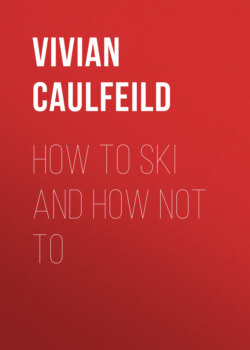Читать книгу How To Ski and How Not To - Vivian Caulfeild - Страница 6
На сайте Литреса книга снята с продажи.
THE SKI
ОглавлениеTable of Contents
The Wood.—Skis are usually made of ash, which is, perhaps, on the whole, a more suitable wood than any other. Hickory is excellent, but is said to be more brittle than ash, and is also heavier. It is, however, but little heavier than the best ash, for in the latter wood lightness means bad quality. The wood must be well seasoned, and as free as possible from knots, especially near the bend and the binding, though small knots which do not extend through the whole thickness of the ski cannot do much harm.
The grain of the wood should be wide and well marked. The way it runs in the ski is most important; it should run parallel with the long axis of the ski throughout its length, above all at the front bend and the binding; for if the grain run out at these points, the ski will be very liable to break there. If anywhere else the grain runs out at all, see that it does so in such a way that the lines on the side of the ski run backwards and downwards (Fig. 1, a), not forwards and downwards (Fig. 1, b).
Fig. 1.
Cross-grain; in a it does not much matter, as it only occurs at some distance from the binding and points backwards; b is very bad.
If the lines of grain on the sole of the ski run across at all instead of parallel to the sides, the ski, when it gets rather worn, will not run straight. If, of a pair of skis, one runs to the right and one to the left, it does not much matter, for in that case the former can be put on the left foot and the latter on the right; they will then merely keep together and hold each other straight.
But if both skis run off to the same side there is nothing to be done, so look carefully at the grain of the sole when choosing them, to see that there is no chance of this (Fig. 2).
Fig. 2.
Cross-grain on running surface: a converging, not very serious; b parallel, very bad.
There is one more point to be noticed about the arrangement of the grain in the ski.
If you look at the heel end of the ski, you will generally see the grain disposed in vertical lines, as in Fig. 3, b. The ski will not only be stronger and more springy, but will wear better and run faster if cut so that the grain lies horizontally (Fig. 3, c).[1] Fig. 3, a shows a disposition of the grain which is likely to weaken the ski and should be avoided.
Fig. 3.
a bad, b good, c still better.
The colour of a ski is a matter of taste. Dark colours have the disadvantage of causing the snow which collects on the top of the ski to melt more readily; it may then refreeze and accumulate, forming an unnecessary load of ice.
A dark colour also makes it more difficult to detect faults in the grain, and it is wiser for this reason to buy plain varnished skis, and colour them afterwards if you want them darker.
New skis should be given several coats of boiled linseed oil, each being allowed to sink in before the next is applied. When at last the wood will absorb no more, give it a coat of raw linseed oil; this dries hard, with a surface just rough enough for easy climbing, but slippery enough to make waxing unnecessary, except for the very stickiest snow. The more often skis are oiled, even when in use, the better.
Dimensions.—When you are standing with your arm stretched at full length above your head, the ski, placed upright, should be at least long enough for its tip to reach the roots of your fingers; it may well reach a few inches beyond the finger-ends.
Fig. 4.
The longer the ski the pleasanter you will find it for straight-running. On a long ski you keep your balance more easily, run more smoothly on rough ground, and keep a straight course with less trouble. A short ski is slightly easier for turning, but if you learn correct methods of turning, the difference is insignificant; and in any case, however much you may twist and turn, you are bound for the greater part of the time to be running straight, and you might as well do so as comfortably as possible.
The ski should be as narrow as possible, hardly more than 2¾ inches (7 centimetres) at the narrowest part—i.e. where the foot rests on it—even for the biggest man.
If it measures 2¾ inches in width at the narrowest part, it should be about 3¾ inches wide at the front bend, and just over 3 inches at the heel.
A narrow ski is in every way better than a wide one; the only object of increasing the width of a ski is to make its bearing surface on the snow proportionate to the weight of a heavier man, and so to prevent it from sinking more deeply and therefore running more slowly. But this should be done by increasing the length rather than the width.
The beginner usually imagines that the wider the ski the more easily he will be able to balance on it. This is a great mistake. A narrow ski is far steadier than a wide one for straight running; it is easier for turning, and infinitely more comfortable for moving across a steep slope of hard snow, the diminished leverage putting less strain on the ankles, as the diagram shows.[2]
